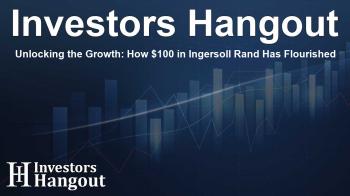Unlocking the Growth: How $100 in Ingersoll Rand Has Flourished

Unlocking the Growth Potential of Ingersoll Rand
Investing in stocks can be a rewarding journey, especially when decisions are backed by data. Ingersoll Rand (NYSE: IR) stands as a noteworthy player in the market, showcasing a remarkable performance over the past five years. This article explores how a $100 investment in IR has blossomed alongside the company's impressive growth.
The Journey of Ingersoll Rand
Ingersoll Rand has consistently outperformed the broader market, demonstrating an annualized return that eclipses many competitor performances. Remarkably, it has offered investors a solid average return of 20.24%. With a market capitalization of $36.48 billion, Ingersoll Rand is not just a small fish in a vast pond but rather signifies growth and stability within various sectors.
Analyzing the Investment
To put it into perspective, if an investor had committed just $100 to Ingersoll Rand stock five years ago, that investment would now be valued at approximately $249.50, as the stock is trading at about $90.52 at the current time of writing. This impressive rise underscores the power of compounded returns in the financial market.
The Impact of Compounded Returns
The crucial takeaway from Ingersoll Rand’s journey is the incredible impact that compounded returns can have over time. An initial investment, no matter how modest it may seem, can lead to engaging growth when it is consistently supported by solid performance metrics and market strategies.
Investor Sentiment and Future Outlook
As Ingersoll Rand continues to expand and innovate in its industry, investor sentiment remains positive. The focus on sustainability and advanced technologies within their offerings positions them well for future growth. Investors are advised to keep an eye on the company, as it reflects resilience and adaptability in a rapidly changing market environment.
Final Thoughts
In conclusion, the story of Ingersoll Rand is not just about numbers; it highlights the potential for transformation through strategic investment. Understanding how your money can grow with time through smart stock choices can alter your financial trajectory significantly.
Frequently Asked Questions
What is the historical return on investment for Ingersoll Rand?
Ingersoll Rand has delivered a remarkable average annual return of 20.24% over the past five years, significantly outperforming the market.
How much would a $100 investment today be worth in the future?
While future performance can’t be guaranteed, if Ingersoll Rand continues its trend, a $100 investment may yield substantial returns over time.
What factors contribute to Ingersoll Rand's growth?
Ingersoll Rand's growth can be attributed to its focus on innovation, market expansion, and a commitment to sustainability in its operations.
Is Ingersoll Rand a good investment for the long term?
Based on its historical performance and growth strategies, many investors consider Ingersoll Rand a promising candidate for long-term investment.
How does compounded return affect investments?
Compounded returns significantly enhance investment growth over time by reinvesting earnings, leading to accelerated wealth accumulation.
About Investors Hangout
Investors Hangout is a leading online stock forum for financial discussion and learning, offering a wide range of free tools and resources. It draws in traders of all levels, who exchange market knowledge, investigate trading tactics, and keep an eye on industry developments in real time. Featuring financial articles, stock message boards, quotes, charts, company profiles, and live news updates. Through cooperative learning and a wealth of informational resources, it helps users from novices creating their first portfolios to experts honing their techniques. Join Investors Hangout today: https://investorshangout.com/
Disclaimer: The content of this article is solely for general informational purposes only; it does not represent legal, financial, or investment advice. Investors Hangout does not offer financial advice; the author is not a licensed financial advisor. Consult a qualified advisor before making any financial or investment decisions based on this article. The author's interpretation of publicly available data shapes the opinions presented here; as a result, they should not be taken as advice to purchase, sell, or hold any securities mentioned or any other investments. The author does not guarantee the accuracy, completeness, or timeliness of any material, providing it "as is." Information and market conditions may change; past performance is not indicative of future outcomes. If any of the material offered here is inaccurate, please contact us for corrections.
